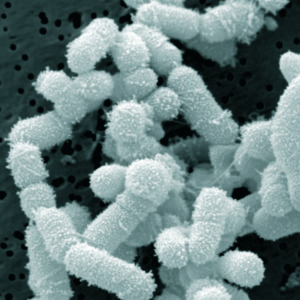Now we are finally finding out about all the microbes we encounter when go through New York City's subway system: touching handrails, turnstiles, and just sitting on benches. This study looked at the microbial communities of NYC's subway system. From the Wall Street Journal:
Big Data and Bacteria: Mapping the New York Subway’s DNA
Aboard a No. 6 local train in Manhattan, Weill Cornell researcher Christopher Mason patiently rubbed a nylon swab back and forth along a metal handrail, collecting DNA in an effort to identify the bacteria in the New York City subway. In 18 months of scouring the entire system, he has found germs that can cause bubonic plague uptown, meningitis in midtown, stomach trouble in the financial district and antibiotic-resistant infections throughout the boroughs.
The big-data project, the first genetic profile of a metropolitan transit system, is in many ways “a mirror of the people themselves who ride the subway,” said Dr. Mason, a geneticist at the Weill Cornell Medical College... By documenting the miniature wildlife, microbiologists hope to discover new ways to track disease outbreaks—including contagious diseases like Ebola or measles—detect bioterrorism attacks and combat the growing antibiotic resistance among microbes, which causes about 1.7 million hospital infections every year.“We know next to nothing about the ecology of urban environments,” said evolutionary biologist Jonathan Eisen at the University of California at Davis. “How will we know if there is something abnormal if we don’t know what normal is?”
Dr. Mason and his research team gathered DNA from turnstiles, ticket kiosks, railings and benches in a transit system shared by 5.5 million riders every day. They sequenced the genetic material they found at the subway’s 466 open stations—more than 10 billion fragments of biochemical code—and sorted it by supercomputer. They compared the results to genetic databases of known bacteria, viruses and other life-forms to identify these all-but-invisible fellow travelers.
In the process, they uncovered how commuters seed the city subways every day with bacteria from the food they eat, the pets or plants they keep, and their shoes, trash, sneezes and unwashed hands. The team detected signs of 15,152 types of life-forms. Almost half of the DNA belonged to bacteria—most of them harmless; the scientists said the levels of bacteria they detected pose no public-health problem. Data from the PathoMap Project, as Dr. Mason calls it, was published online in the journal Cell Systems on Thursday.
As more and more scientists probe urban microbiology, they are also hoping to find ways to foster beneficial bacteria through building design and to learn how to eliminate construction practices that create living conditions for the germs that make people ill.
This emerging field reflects the growing awareness that the human body swarms with bacteria. Typically, every person is home to about a hundred trillion microbial cells bearing five million different genes, totaling about 5 pounds of micro-organisms per person. Indeed, microbes in and on the body outnumber human cells about 10 to one. The body’s collection of microbes, called the microbiome, influences health in ways that researchers are only beginning to understand.
Broadly speaking, city living leaves its mark on people. That includes the sorts of microbes that collect inside them. A recent comparison of urban and rural residents in Russia found that city dwellers had different sets of stomach microbes than people in the countryside. Every person trails a distinctive collection of microbes, by shedding about 1.5 million microscopic skin cells every hour. Bacteria from a person’s body can colonize a hotel room in less than six hours, scientists at the U.S. Department of Energy’s Argonne National Laboratory in Illinois recently discovered.
Depending on the material involved, some surfaces can have thousands of different types of bacteria while others may have only a few hundred, researchers monitoring the new Chicago hospital found. Pathogens responsible for common infections, such as the strep germs that cause an estimated 700 million infections world-wide every year, can survive for months on a dry surface, researchers in Germany reported in September in the journal BMC Infectious Diseases.
The New York subway study quickly hit the current limits of science. Most microbes have never been isolated or studied. Only a few thousand creatures of any sort have ever had their entire set of genes analyzed, so identifications of DNA sequences through online computer comparisons can be inaccurate. All told, the biodiversity of the subway isn’t as rich as normal soil. The dirt in Central Park contains 167,000 types of micro-organisms—about 11 times the number of species in the transit system... But a deep breath of subway air contains about as many free-floating bacteria as fresh air at street level, researchers at the University of Colorado Boulder reported last year in the journal Applied and Environmental Microbiology.
No two subway stations were exactly the same, said Weill Cornell project leader Ebrahim Afshinnekoo, who helped analyze the data.The greatest subway biodiversity was found at the Myrtle-Willoughby Avenue stop for the G train in Bedford-Stuyvesant, Brooklyn, where 95 unique bacteria groups were detected....Among the DNA of higher organisms, the researchers found across the system that genetic material from beetles and flies was the most prevalent—the cockroach genome hasn’t been sequenced yet so that DNA wasn’t identified... Human DNA ranked fourth.
So far, scientists have identified 562 species of bacteria, most of them benign or low risk. At least 67 of those species can make people sick. Even these infectious bacteria were all detected at such low levels that they were unlikely to cause illness in a healthy person...Among the pathogenic and infectious bacteria, the Cornell researchers identified DNA related to strep infections at 66 stations and urinary tract infections at 192 stations. They found E. coli at 56 stations and other bacteria related to food poisoning at 215 stations.


 Well DUH, of course eating organic foods lowers pesticide exposures. And yes, it can be measured in your body. So, as previous studies have shown, replacing regular fruits and vegetables (conventionally grown) with organic fruits and vegetables will lower your exposure to pesticides and the levels in your body.
Well DUH, of course eating organic foods lowers pesticide exposures. And yes, it can be measured in your body. So, as previous studies have shown, replacing regular fruits and vegetables (conventionally grown) with organic fruits and vegetables will lower your exposure to pesticides and the levels in your body.
 It is now 104 weeks being free of chronic sinusitis and off all antibiotics! Two full years since I started my easy do-it-yourself sinusitis treatment! And my sinuses feel great! I would never ever have thought such a thing was possible several years ago. Thanks to the probiotic (beneficial bacteria) Lactobacillus sakei I got my life back. Yes, I know I'm gushing...
It is now 104 weeks being free of chronic sinusitis and off all antibiotics! Two full years since I started my easy do-it-yourself sinusitis treatment! And my sinuses feel great! I would never ever have thought such a thing was possible several years ago. Thanks to the probiotic (beneficial bacteria) Lactobacillus sakei I got my life back. Yes, I know I'm gushing... Interesting that less is best when it comes to jogging and health. Found
Interesting that less is best when it comes to jogging and health. Found